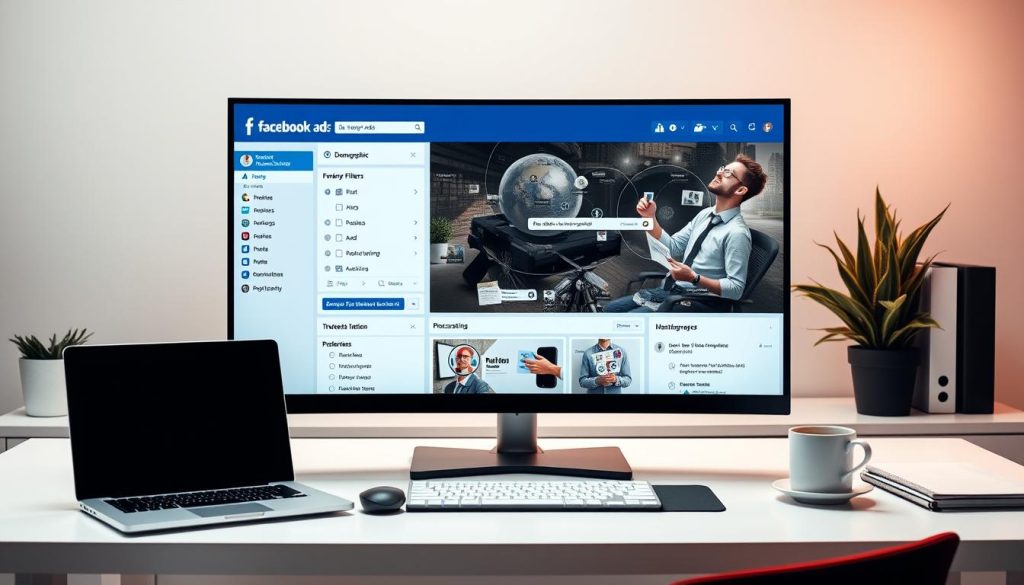With over 3.06 billion users worldwide, Facebook offers a vast potential audience for businesses. As a staple for social media marketers, Facebook Ads have become an essential tool for reaching and engaging target audiences. We will explore the importance of Facebook Ads in digital marketing and provide a comprehensive overview of their functionality.
Understanding Facebook ad campaigns is crucial for businesses seeking to expand their online presence. Effective ad campaigns can drive significant results, from increasing brand awareness to generating leads and sales. We will delve into the mechanics of Facebook Ads, providing insights into their role in a successful marketing strategy.
Key Takeaways
- Understanding the basics of Facebook Ads and their importance in digital marketing
- Recognizing the potential audience reach on Facebook
- Learning how to create effective ad campaigns
- Understanding the role of Facebook Ads in a successful marketing strategy
- Discovering the benefits of using Facebook Ads for business growth
Understanding Facebook Ads: An Overview
Facebook’s advertising platform provides businesses with a unique opportunity to connect with potential customers worldwide. With its vast user base and advanced targeting capabilities, Facebook Ads have become a crucial component of many businesses’ marketing strategies.
What Are Facebook Ads?
Facebook Ads are a form of online advertising that allows businesses to reach their target audience based on demographics, interests, behaviors, and more. These ads can be in the form of images, videos, or text, and are designed to drive traffic, generate leads, or boost sales.
Key Features of Facebook Ads:
- Advanced targeting options
- Variety of ad formats
- Real-time performance tracking
- Flexible budgeting options
Benefits of Using Facebook Ads
The benefits of using Facebook Ads are numerous. They offer a cost-effective way to reach a large audience, with the ability to track the performance of your ads in real-time. Facebook Ads also provide a high degree of flexibility, allowing businesses to adjust their campaigns on the fly to optimize results.
Some key benefits include:
| Benefit | Description |
|---|---|
| Targeted Advertising | Reach your ideal customer based on demographics, interests, and behaviors. |
| Measurable ROI | Track the performance of your ads and measure return on investment. |
| Flexibility | Adjust your campaigns in real-time to optimize results. |
The Role of Targeting in Facebook Ads
Targeting is at the heart of Facebook’s advertising platform. By allowing businesses to specify their ideal audience, Facebook Ads ensure that your message reaches those most likely to be interested in your product or service. Facebook ad targeting options include location, age, interests, behaviors, and more, giving you the precision to reach your desired audience.

Effective targeting is crucial for the success of your Facebook Ads campaigns. By understanding your audience and using Facebook’s targeting capabilities, you can significantly improve the performance of your ads, driving better results for your business.
The Facebook Advertising Ecosystem
Understanding the Facebook advertising ecosystem is crucial for any business looking to leverage the platform’s vast user base. The ecosystem encompasses various tools and features that work together to help advertisers achieve their marketing objectives.

Overview of Facebook Advertising Platform
The Facebook Ads Manager is a sophisticated dashboard that provides an overview of all campaigns, allowing advertisers to monitor performance, adjust strategies, and optimize ad delivery. As noted in a study on Facebook’s ad delivery mechanisms Facebook’s ad delivery process is complex and influenced by various factors including user behavior and ad content.
The Ads Manager is designed to be user-friendly, offering a range of tools and insights that help advertisers navigate the complexities of the Facebook advertising ecosystem.
Key Components of Facebook Ads
Several key components make up the Facebook Ads ecosystem, including:
- Ad Creative: The visual and textual elements that make up an ad, including images, videos, headlines, and descriptions.
- Targeting Options: Tools that allow advertisers to reach specific audiences based on demographics, interests, behaviors, and more.
- Budgeting and Bidding: Mechanisms for setting ad budgets and bidding strategies that determine ad delivery and cost.
- Performance Metrics: Data points that measure ad performance, such as click-through rates, conversions, and return on ad spend.
Types of Facebook Ads Offered
Facebook offers a diverse range of ad formats to suit different marketing objectives, including:
- Image Ads: Simple, visually engaging ads that include a single image.
- Video Ads: More dynamic ads that use video content to capture user attention.
- Carousel Ads: Ads that allow multiple images or videos to be showcased in a single ad unit.
- Collection Ads: Ads that enable users to browse and purchase products directly from the ad.
- Lead Ads: Ads designed to capture user information, such as email addresses, to generate leads.
By understanding these components and ad types, advertisers can better navigate the Facebook advertising ecosystem and create effective ad campaigns that drive results.
Setting Up Your Facebook Ads Account
Before you can launch your first Facebook ad, you need to set up your Facebook Ads account, a straightforward process that we will guide you through. To use Facebook Ads Manager, you need a Facebook Business Page, which serves as the foundation for your advertising efforts.
Step-by-Step Account Creation
To start, you’ll need to create a Facebook Business Page if you haven’t already. This page will be linked to your Ads Manager account. Here’s how to get started:
- Go to Facebook and log in to your personal account.
- Navigate to the “Pages” section and click on “Create New Page.”
- Follow the prompts to set up your Page, including adding a profile picture, cover photo, and Page details.
- Once your Page is set up, you can access Ads Manager by clicking on “Manage Page” and then “Create Ads.”
For a more detailed guide, you can refer to our resource on setting up your Facebook Ads account.
Navigating the Ads Manager
Ads Manager is your central hub for creating, managing, and tracking your Facebook ads. To navigate Ads Manager effectively:
- Familiarize yourself with the dashboard, which provides an overview of your campaigns, ad sets, and ads.
- Use the navigation menu to access different sections, such as Campaigns, Ad Sets, and Ads.
- Understand the different metrics and reports available to track your ad performance.

Essential Settings for Your Ads Account
Configuring the right settings for your Ads account is crucial for successful Facebook advertising. Here are some essential settings to consider:
- Currency and Time Zone: Ensure these are set correctly to avoid any discrepancies in your ad spend and scheduling.
- Payment Method: Add a valid payment method to fund your ad campaigns.
- Tracking: Set up Facebook Pixel to track conversions and optimize your ads for better performance.
By following these steps and configuring the essential settings, you’ll be well on your way to running successful Facebook ad campaigns. For more tips for successful Facebook advertising, stay tuned for our future guides.
Defining Your Target Audience
The foundation of a successful Facebook ad strategy lies in accurately defining your target audience. By understanding who your ideal customers are, you can tailor your ads to resonate with them, thereby enhancing the overall performance of your campaigns.
Importance of Audience Segmentation
Audience segmentation is crucial because it allows you to divide your broad audience into smaller, more manageable groups based on demographics, interests, and behaviors. This targeted approach ensures that your ads are seen by those most likely to be interested in your products or services.
By segmenting your audience, you can:
- Increase the relevance of your ads
- Improve ad performance and ROI
- Enhance customer engagement and conversion rates
Tools for Audience Targeting
Facebook offers a range of tools to help you target your audience effectively. These include:
- Core Audiences: Allows you to target users based on location, age, gender, interests, and more.
- Custom Audiences: Enables you to target existing customers or users who have interacted with your business.
- Lookalike Audiences: Helps you reach new people who are similar to your existing customers or followers.
Utilizing these tools, you can precisely target your audience and optimize your ad campaigns for better results.
Custom Audiences vs. Lookalike Audiences
Understanding the difference between custom audiences and lookalike audiences is vital for optimizing your Facebook ad targeting.
Custom Audiences are created based on your existing data, such as customer lists, website traffic, or app users. They allow you to target people who have already shown interest in your business.
Lookalike Audiences, on the other hand, are created by Facebook’s algorithms to find users who resemble your custom audiences. This tool is particularly useful for expanding your reach to potential customers who are likely to be interested in your offerings.

By leveraging both custom and lookalike audiences, you can maximize your ad reach and effectiveness, driving more conversions and sales.
Crafting Effective Ad Content
Effective ad content is the backbone of any successful Facebook advertising strategy. We understand that creating engaging ads is crucial for capturing users’ attention in a crowded digital landscape.

The Elements of Successful Ads
Successful Facebook ads typically have several key elements. Clear messaging is paramount; it should resonate with your target audience and align with your overall marketing goals. We also emphasize the importance of relevance, ensuring that your ad content speaks directly to the interests and needs of your audience.
Another critical element is visual appeal. Using high-quality images or videos can significantly enhance the effectiveness of your ads. For more insights on creating compelling content, you can explore resources on content marketing strategies.
Best Practices for Ad Copy
When it comes to ad copy, clarity and conciseness are key. We recommend keeping your messaging straightforward and focused on the benefits that matter most to your audience. It’s also essential to include a clear call-to-action (CTA), guiding users on what steps to take next.
- Use action-oriented language to encourage engagement.
- Personalize your ad copy to resonate with different segments of your audience.
- Test different variations of your ad copy to identify what works best.
Utilizing Visuals in Your Ads
Visuals play a crucial role in capturing attention and conveying your message effectively. We suggest using high-quality images that are relevant to your ad content and resonate with your target audience. Additionally, videos can be a powerful tool, offering a more dynamic way to engage users.
To optimize your ad visuals, consider the following tips:
- Use eye-catching colors and graphics to make your ad stand out.
- Ensure your visuals are consistent with your brand identity.
- Test different visual elements to see what performs best with your audience.
By focusing on these aspects, you can significantly improve the effectiveness of your Facebook ads and achieve better results from your advertising efforts.
Budgeting for Facebook Ads
A well-planned budget is the backbone of any successful Facebook Ads campaign. To maximize your return on investment (ROI), you need to understand how to allocate your budget effectively.
Different Budget Types
Facebook Ads offers two primary budget types: daily and lifetime budgets. A daily budget is the average amount you’re willing to spend per day, while a lifetime budget is the total amount you’re willing to spend over the entire duration of your campaign.
Choosing between these budget types depends on your advertising goals and campaign duration. For short-term campaigns, a lifetime budget might be more suitable, while ongoing campaigns might benefit from a daily budget.
| Budget Type | Description | Best For |
|---|---|---|
| Daily Budget | Average amount spent per day | Ongoing campaigns |
| Lifetime Budget | Total amount spent over campaign duration | Short-term campaigns |
Bidding Strategies Explained
Bidding strategies determine how you pay for your ads on Facebook. The platform offers several bidding strategies, including Cost Per Click (CPC), Cost Per Thousand Impressions (CPM), and Cost Per Action (CPA).
Understanding these strategies is crucial for optimizing facebook ad performance. For instance, CPC is ideal for driving traffic to your website, while CPM is better suited for increasing brand awareness.
- CPC: Pay for each ad click
- CPM: Pay for every 1,000 ad impressions
- CPA: Pay for specific actions (e.g., conversions)
Setting Up Your Ad Budget
To set up your ad budget on Facebook, navigate to the Ads Manager and follow these steps:
- Choose your campaign objective
- Select your budget type (daily or lifetime)
- Set your bid strategy
- Monitor and adjust your budget as needed
Regularly reviewing your ad performance helps in making informed decisions about your budget allocation, ensuring you’re getting the best possible ROI.

By understanding and effectively managing your Facebook Ads budget, you can significantly improve your campaign’s performance and achieve your advertising goals.
Running Your First Facebook Ad Campaign
Creating a successful Facebook ad campaign requires strategic planning and execution. To get started, you need to understand the fundamentals of how Facebook Ads work and how to leverage them for your business goals.
Choosing Your Advertising Objective
The first step in running a Facebook ad campaign is selecting the right advertising objective. Facebook offers a range of objectives that cater to different business goals, from brand awareness and lead generation to conversions and sales. Choosing the right objective is crucial as it determines how your ads are optimized and delivered.
For instance, if your goal is to drive sales, you might choose the “Conversions” objective. On the other hand, if you’re looking to increase your brand’s visibility, “Brand Awareness” or “Reach” might be more appropriate. Facebook’s Ads Manager will guide you through the process, helping you select the objective that best aligns with your marketing strategy.
Campaign Structure and Setup
Once you’ve chosen your advertising objective, it’s time to set up your campaign structure. Facebook Ads are organized into three main levels: Campaign, Ad Set, and Ad. Understanding this structure is key to managing your ads effectively.
- Campaign Level: This is where you define your advertising objective.
- Ad Set Level: Here, you specify your target audience, budget, and schedule.
- Ad Level: This is where you create your actual ads, including images, videos, and ad copy.
| Campaign Level | Ad Set Level | Ad Level |
|---|---|---|
| Define Advertising Objective | Specify Target Audience, Budget, Schedule | Create Ad Content (Images, Videos, Copy) |
| Choose from various objectives like Awareness, Consideration, Conversion | Set budget (daily or lifetime), schedule ads | Use high-quality visuals and compelling copy |
Ad Scheduling and Placement Options
Ad scheduling and placement are critical components of your Facebook ad campaign. You can choose when and where your ads are shown to maximize their effectiveness. Facebook offers various placement options, including the News Feed, Stories, and the right-hand column.
By carefully selecting your ad placements, you can ensure that your ads reach your target audience at the right time. For example, if your target audience is more active on Instagram, you can choose to display your ads on Instagram Stories or Feed.
Running a successful Facebook ad campaign involves more than just setting up your ads. It requires ongoing monitoring and optimization to ensure that your ads are performing well and meeting your business objectives.
Analyzing Ad Performance
Understanding ad performance metrics is vital for making data-driven decisions on Facebook Ads. Analyzing ad performance helps us optimize our campaigns for better results and higher return on investment (ROI).
Metrics to Track and Evaluate
To effectively analyze ad performance, we need to track the right metrics. Key performance indicators (KPIs) such as click-through rate (CTR), conversion rate, cost per click (CPC), and return on ad spend (ROAS) provide valuable insights into ad effectiveness.
We should also consider metrics like reach, impressions, and frequency to understand how our ads are being consumed. By monitoring these metrics, we can identify areas for improvement and adjust our ad strategies accordingly.
Using Facebook Analytics Tools
Facebook provides a range of analytics tools to help us track and evaluate ad performance. Facebook Ads Manager is a powerful tool that offers detailed insights into ad performance, including metrics like CTR, conversions, and CPC.
Additionally, Facebook’s split testing feature allows us to compare different ad variations and identify top-performing ads. By leveraging these tools, we can make informed decisions to optimize our ad campaigns.
Understanding ROI and Conversion Tracking
Understanding ROI and conversion tracking is critical for evaluating the effectiveness of our Facebook Ads. ROI measures the return on investment, while conversion tracking helps us understand which ads are driving specific actions, such as purchases or sign-ups.
By setting up conversion tracking, we can attribute specific actions to our ads and measure their impact on our business goals. This information enables us to optimize our ad campaigns for better ROI and improved overall performance.
By regularly analyzing ad performance and leveraging Facebook’s analytics tools, we can refine our ad strategies and achieve better results. Effective analysis and optimization are key to maximizing the potential of Facebook Ads.
A/B Testing Your Ads
In the ever-evolving landscape of Facebook advertising, A/B testing stands out as a key strategy for success. By experimenting with different ad elements, businesses can make data-driven decisions to enhance their ad performance.
Importance of Split Testing
A/B testing, or split testing, allows us to compare two or more versions of an ad to determine which one performs better. This method is crucial for optimizing Facebook ad performance and ensuring that our advertising efforts yield the best possible results.
By identifying which ad elements resonate with our target audience, we can refine our advertising strategy to improve engagement, conversions, and ultimately, return on investment (ROI).
How to Run A/B Tests on Facebook
Running A/B tests on Facebook is a straightforward process that involves creating a campaign with multiple ad sets or ads, each with a variable element we want to test. Here’s a step-by-step guide:
- Create a new campaign in Facebook Ads Manager with the A/B test option enabled.
- Define your test variable, such as ad creative, headline, or call-to-action (CTA) button.
- Set up your ad sets with the variable element and ensure that the rest of the ad components remain consistent.
- Facebook will automatically split your audience into groups and show each group a different version of the ad.
- Monitor the performance of each ad version and let the test run until Facebook determines a winner based on your selected metric.
Analyzing Results and Making Adjustments
Once the A/B test is complete, we analyze the results to understand which ad version performed better and why. This involves looking at key metrics such as click-through rate (CTR), conversion rate, and cost per conversion.
By applying the insights gained from A/B testing, we can make informed adjustments to our ad campaigns to improve their effectiveness. This might involve scaling up successful ads, tweaking underperforming ones, or entirely new creative approaches based on the data.
For tips for successful Facebook advertising, it’s essential to continuously iterate and refine our ad strategies based on A/B test results, ensuring that our campaigns remain optimized for the best possible performance.
Common Challenges in Facebook Advertising
Despite its potential, Facebook advertising is not without its hurdles, including ad fatigue and policy restrictions. As advertisers, we must navigate these challenges to ensure the success of our campaigns.
Addressing Ad Fatigue
Ad fatigue occurs when our target audience becomes desensitized to our ads due to repeated exposure. To combat this, we need to refresh our ad creative regularly.
Here are some strategies to address ad fatigue:
- Rotate ad creatives every few weeks
- Use different ad formats, such as videos or carousels
- Target new audiences to expand our reach
Navigating Policy Restrictions
Facebook has strict policies governing ad content. To avoid having our ads rejected, we must understand these policies.
Some key areas to focus on include:
- Compliance with Facebook’s advertising policies
- Avoiding prohibited content, such as misleading claims
- Ensuring transparency in our ad practices
Handling Competition and Market Saturation
The Facebook advertising landscape is highly competitive. To stand out, we need to develop a robust strategy.
Key considerations include:
| Strategy | Description | Benefits |
|---|---|---|
| Targeted Advertising | Focus on specific demographics and interests | Increased ad relevance, better ROI |
| Ad Creative Optimization | Use compelling visuals and copy | Higher engagement rates, improved brand recall |
| Budget Allocation | Effectively manage ad spend across campaigns | Maximized ROI, reduced waste |
By understanding and addressing these common challenges, we can develop effective strategies for successful Facebook advertising.
Tips for Long-term Success with Facebook Ads
To achieve sustained success with Facebook Ads, we must continually adapt and refine our approach. This involves evolving our strategy over time, staying updated with the latest trends and changes, and building a community around our brand.
Adapting to Change
Successful Facebook advertising requires continuous optimization. We must regularly review our ad performance, adjusting our targeting, ad creative, and bidding strategies as needed to ensure optimal results.
Staying Ahead of the Curve
Staying updated with the latest Facebook Ads trends and changes is crucial. We can do this by following industry leaders, attending webinars, and leveraging Facebook’s resources to stay informed about best practices for optimizing Facebook ad performance.
Building a Loyal Community
Building a community around our brand is vital for long-term success. By engaging with our audience, responding to comments, and creating relevant content, we can foster a loyal following that drives sustained growth and conversions, ultimately providing valuable tips for successful Facebook advertising.
